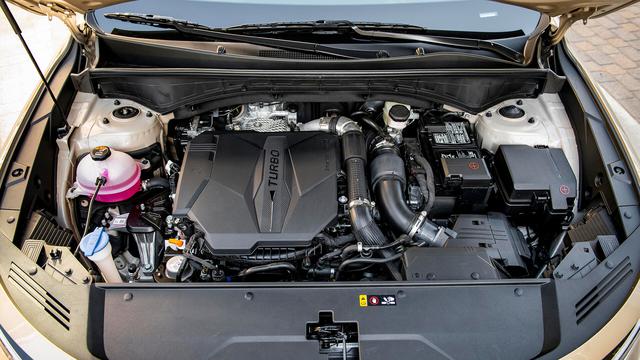Contenders in our Of The Year competitions are judged on the merits of the entire vehicle lineup. That somewhat smoothed the Kia Telluride's win in our 2020 SUV contest, as it's only offered with a 3.8-liter V-6. When the Sorento slid into 2022 SUVOTY's finalist round, it did so with two of its engine choices represented: the hybrid and the 2.5-liter turbocharged I-4, which is the engine featured in our golden SX-trim long-termer. The Sorento's base 2.5-liter naturally aspirated I-4 was also present, albeit bolted into a different SUV. We've also tested the plug-in hybrid variant, added to the range for 2022.
But Sorento intenders aren't buying the entire lineup—they're going home with only one. Now that we've tried every engine, let us lay out our thoughts and ultimate recommendation on which makes the best Sorento experience.
The asterisk is because we haven't sampled this engine in the Sorento specifically, but our assessments of it in other similar vehicles suggest that we aren't missing much. The base 2.5-liter I-4 produces 191 hp and 184 lb-ft of torque, and it comes connected to an eight-speed automatic transmission. FWD is standard, AWD optional. It's fundamentally a shared powertrain with the smaller Hyundai Tucson, in which we called the engine "barely adequate." (The 2023 Kia Sportage offers the same powertrain, as well.) Our test drivers measured a 9.3-second 0-60-mph time from a Tucson with this engine, and a comparable Sorento weighs some 270 pounds more.
Nor does this naturally aspirated engine return worthwhile fuel economy advantages in the Sorento; the base engine and the turbo-four upgrade both earn a 24-mpg combined rating from the EPA on cars equipped with all-wheel drive, though the base engine edges ahead by 1 mpg in front-drive guise. Models with the base engine run from about $31,000 to $35,600, and they're the only ones to offer a seven-seat layout—every other engine mandates a six-seat setup. If you can sacrifice the seating capacity, choose any other.
Fuel efficiency is the primary appeal of most hybrids, and the Sorento Hybrid delivers. Its 1.6-liter turbocharged I-4 pairs with an electric motor to produce 227 hp and 258 lb-ft, plus improved economy: as high as 39/35 mpg city highway with FWD, while comparable 2.5 and turbocharged 2.5 models get 24/29 and 22/29 mpg, respectively. What's more, it can cover an astounding 655 miles between fill-ups, allowing a nonstop drive from Detroit to Manhattan, or a Los Angeles-Las Vegas round trip with gallons to spare.

But we've found the hybrid's power delivery to be nonlinear, trailing off after about 50 mph; acceleration to 60 takes 8.4 seconds. We'd only go Sorento Hybrid for its fuel economy—it's the best of any three-row hybrid SUV's. Otherwise, it's uninspiring. Prices run from $35,300 to $39,600.
In our view, using no fuel at all is even better than excellent fuel economy. The Sorento Plug-In Hybrid makes it a reality. Like the hybrid, the plug-in packs a 1.6-liter turbocharged I-4, but it spins its more powerful electric motor with juice from a 13.8-kWh battery for totals of 261 hp and 258 lb-ft. Crucially, that battery enables up to 32 miles of all-electric range, enough to cover daily duties for millions of drivers. It's also quicker to 60 mph, clocking a 7.4-second time.
True, the EPA combined fuel economy of 34 mpg is slightly less than the Sorento Hybrid's, and refuels are needed at 460-mile intervals. However, savvy Sorentoists with ready access to recharging can stretch the time—as opposed to total distance—between gas station visits by running on electrons alone. With standard AWD, the electric motor operates smoothly and silently in around-town driving.
Why isn't the plug-in our pick of the Sorento range? Because it's not exceptionally refined; the powertrain often exhibits a delay in response when departing from a stop. Then there's its price, about $46,400 to nearly $50,000, depending on spec. Even so, the Sorento Plug-In Hybrid has appeal for those of us who see the promise of all-electric driving in their family SUV.
This is the engine that propelled the Sorento to the SUVOTY finalist cut. With that 2.5-liter turbocharged I-4 underhood, we called the Sorento "the feel-good hit of the competition" and were roundly pleased by its sporty vibe. Its 281 hp and 311 lb-ft feels great in our long-termer, which scooted to 60 mph in 6.4 seconds. Thanks to the turbocharger, that oomph remains on tap even at the five-figure elevations we've reached in our mountainous Sorento road trips. Adding to its appeal is how fuel economy of 22/29 with FWD and 22/27 with AWD is in line with the lethargic base four-banger's; Kia recommends 87-octane gas, too.
The 2.5T's main drawback is its transmission: an eight-speed dual-clutch automatic. Every staffer who's driven our long-termer has commented on its rough starts and low-speed stuttering as the clutches engage. The vibrations it sends through the vehicle are hard to ignore, a gripe from our earliest Sorento drives. Those quibbles fade once underway, as the box shifts crisply and adds to the Sorento's swift, fun vibe. As prices range from $36,700 to $44,400, there's value in models equipped with this engine, too.
Every Sorento looks great and offers the same functionality, but we'd pick the 2.5T engine. It's a big part of the enjoyment we're finding in our long-term review SUV.
Looks good! More details?Share on FacebookShare on Twitter




